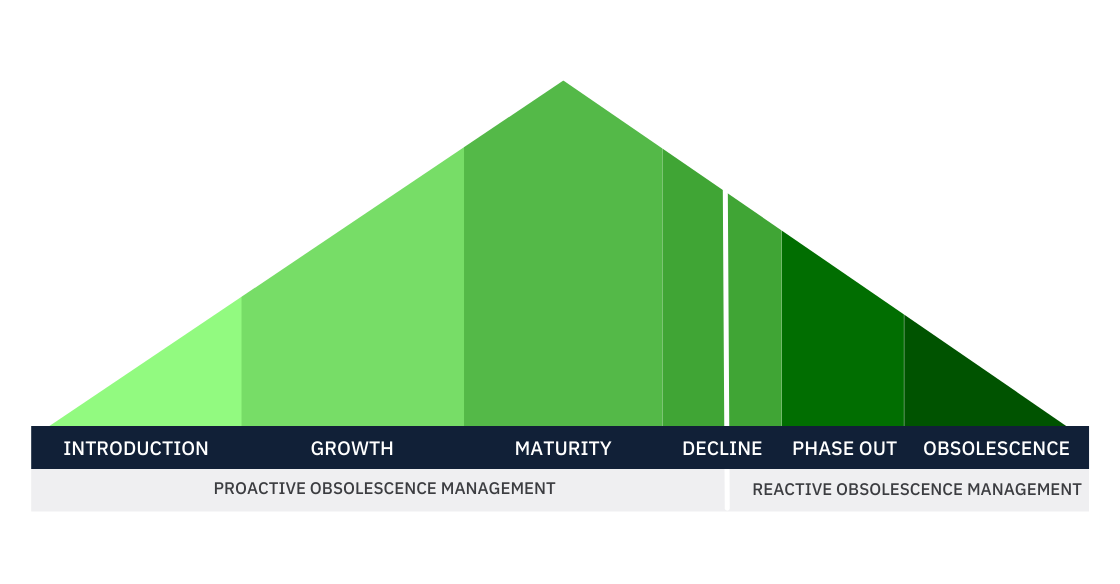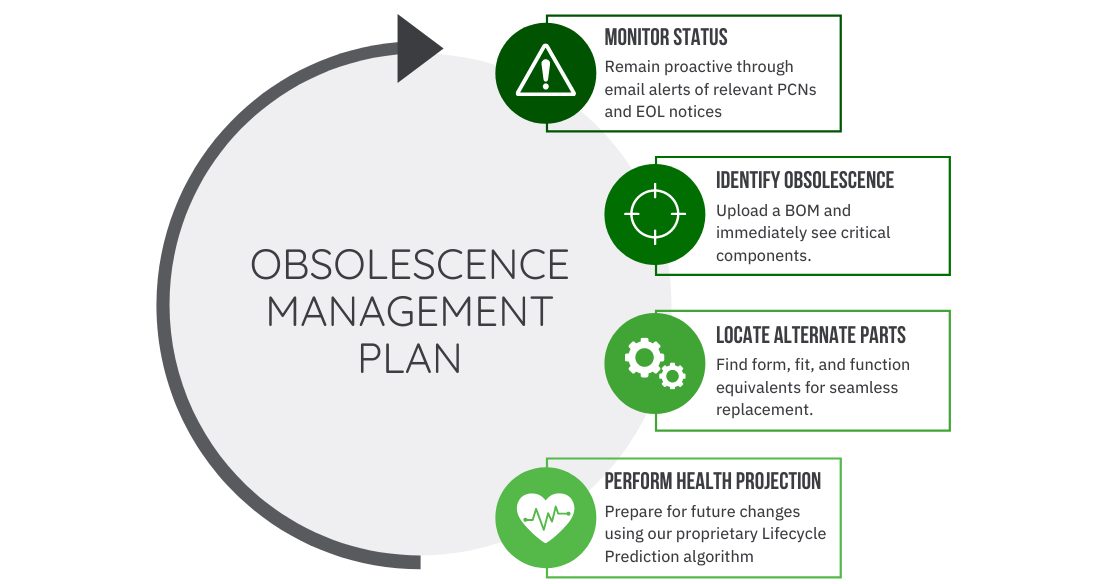Electronic Component Obsolescence Management & Your Supply Chain
The pace of technological development is constantly accelerating. These advancements force suppliers to strategically discontinue production of existing parts to dedicate resources to newer, more advanced, higher-demand components. Obsolescence management is a strategy designed to manage this component turnover, and it is critical to maintaining business strategy and product reliability over the long term.
But there are many issues beyond keeping up with technological growth. Obsolescence management also addresses many supply chain constraints including:
- feverish demand
- inadequate supply
- external constraints such as pandemic lockdown and raw material shortages
What is obsolescence management? Why is it fundamental to long-term business success? How does it help companies mitigate the challenges of a constantly evolving technological landscape?
This article will answer each of these questions and demonstrate why ignoring the risks of inevitable component obsolescence can be devastating.
Understanding Electronic Component Obsolescence Management
What Is Obsolescence Management?
Obsolescence management is a set of actions that can proactively mitigate risks surrounding a product’s lifecycle. These risks are associated with components becoming unavailable and affecting the production or maintenance of a product or system.
A common yet costly example is when production is halted due to a lack of active sources for a single component. For example, cell phone production is delayed because the phone maker was unaware of the obsolescence of a critical line of resistors. Without advance planning and mitigation strategies in place to account for the upcoming component sourcing issues, companies risk millions of dollars in production stoppages.
This can be seen through the difficulties to purchase a PS5 or Xbox console. Thanks to a surge in demand for the graphics card AMD GPU and the current COVID-19 effects on the supply chain, Sony and Microsoft can’t produce enough to meet demands. The lack of having a mitigation strategy has caused huge losses in profit for both popular gaming console companies.
Obsolescence management enables manufacturers to :
- Anticipate lifecycle risks and their impacts before they become costly production issues
- Maintain accurate data to support business strategies throughout the product lifecycle
Before planning an obsolescence management strategy, you should answer core questions that will help devise the best course of action.
When Will Parts Become Obsolete?
You may think you need a crystal ball to predict the future. With an effective obsolescence plan, however, there are several ways to gain insight:
- Scarcity of raw materials
- New regulations on substances
- Increased lead times
- Mergers and acquisitions
- Other disruptions (natural disasters, pandemics, etc.)
 Obsolescence is no longer just about a component becoming outdated and outperformed or phased out of portfolios. Going back to the earlier example, it is also about managing availability issues due to insufficient production capacity or uncontrollable events.
Obsolescence is no longer just about a component becoming outdated and outperformed or phased out of portfolios. Going back to the earlier example, it is also about managing availability issues due to insufficient production capacity or uncontrollable events.
The automotive industry is another perfect example of a sector where several factors drive chip shortages. According to Motor Trends, automakers have become creative in response to increased chip prices, halted production due to COVID, and low inventory of “lower-tech” legacy chips. As a consequence, models coming out of assembly lines may no longer support navigation systems or even remote door locks.
Product Change Notice Alerts (PCNs) are a component to addressing this issue. Companies can sign up to receive alerts for End of Life and PCNs that impact part numbers in their Bill of Material (BOM). This targeted alerting allows companies to filter out the PCNs that don’t impact them and narrow their attention only on the certain PCNs they care about on the parts they use.
What Alternatives Are Available?
Electronic component obsolescence is not necessarily bad news if alternatives are accessible.
Similar parts could fulfill design and function requirements, as could manufacturers or distributors looking for new market opportunities. The main concern is if a company can find a new part reactively in time to avoid costly stoppages. There are many time-consuming factors to think about when finding an adequate replacement including:
- Does the replacement component still comply with global regulations?
- Is the replacement part available in the volumes needed?
- Can it get to manufacturers in time without causing delays?
- Can the component be vetted to avoid issues with counterfeit parts?
Obsolescence management allows companies to have ample time to fully explore each of these factors and choose the right replacement part.
How Is Obsolescence Impacting Product Cost?
Even if emergency decisions are acceptable in the short term, they affect product costs and may not be acceptable to your customers or stakeholders in the long term.
Some popular options include lifetime buy and last time buy, each coming with risks to be aware of.
Lifetime buy is quite common in component obsolescence management, but it bears the added cost of procurement from multiple sources for:
- multiple parts
- cost of inventory (especially storage space and the conditions in which electronic parts should be kept)
- disposal should it prove necessary
Last time buys (LBTs) are also performed across several industries. Often times, when an LTB is announced it becomes a procurement race. Customers go head to head to secure enough stock to last through design needs. Many times this creates a shortage that invalidates the previously announced LTB deadline.
Knowing parts are going to be discontinued ahead of time allows you time to buy enough stock to secure your own production needs. This last call immobilizes working capital and requires precise forecasting.
Why Is Component Obsolescence Management Important?
If you know well in advance which component will become obsolete (and have an idea when), you can save significant amounts of time and money. Embracing proactivity rather than reactivity enables you to stay competitive and in front of costly risks.
Long-life equipment containing a significant number of electronic components (A&D, for instance) face heightened obsolescence risks. Systems are built to last decades, yet parts could become scarce (or worse) halfway through. This affects many actors in the supply chain, organization, and end user environment.
Designers, manufacturers, buyers, maintainers, and U.S. Government Program Offices depend on the data they possess and use it to adapt and keep performing their missions as intended:
- Designers and engineers will elaborate alternative options
- Manufacturers may secure inventory based on demand forecast
- Procurement professionals will seek alternative sourcing options
- Maintainers will also work on parts inventory while looking for more efficiency
- U.S. government officials and field operators will take measures to minimize the impact of obsolescence disruption
Advice From Source Intelligence: Don’t Drop The Ball On Lifecycle Risks
Left ignored, parts obsolescence drives up development, production, and maintenance costs, along with potential redesign/conformity costs.
When you talk to our Source Intelligence expert, you will discover the component obsolescence management that provides all you need to:
- Be able to inform your customers of changes in the Bill of Material
- Access obsolescence analysis and predictions via an extensive database
- Generate alerts for PCNs
- Communicate with personnel concerned and involved

Our Obsolescence Management software is designed to help you mitigate and resolve issues by staying ahead of supplier disruption. With one of the largest databases on the market and a full suite of ESG solutions, Source Intelligence is a one-stop-shop for supply chain compliance needs.
Are you ready to make parts obsolescence an asset rather than a liability? Download our Obsolescence Management program brochure for more information today.


.jpg)
